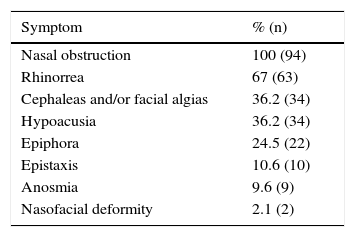To evaluate the clinical presentation, treatment outcome and follow-up of all patients managed with sinonasal papillomas (SP), at a tertiary private otorhinolaryngology centre in Caracas (Venezuela).
Material and methodsWe reviewed 94 patients with SP that were treated at our otolaryngology centre, from July 1st 1993 to June 31st 2015. The demographic data, clinical features, radiological findings, anatomical origin, disease extension into the adjacent structures, surgical approaches performed, histopathology outcomes, recurrent risk, malignant transformation rate and coadjuvant therapies were assessed.
ResultsSixty-five patients (69.1%) were male and 29 (30.9%) female with an average age of 44.5 years (range 9–80 years). All patients underwent endoscopic sinus surgery. The most commont histologic subtypes of SP were inverted papilloma (58 patients; 61.7%), fungiform papilloma (35 patients; 37.2%) and oncocytic papilloma (one patient; 1.1%). SP was associated in 2 patients with undifferentiated squamous cell carcinoma. Twelve patients (12.8%) had disease with extension beyond the sinus without associated malignancy. All these patients received adjuvant treatment with advanced techniques of radiotherapy. The mean duration of the follow-up period was 9 years and 2 months. Eighteen patients (19.1%) had recurrent disease during the entire course of follow-up.
ConclusionsComplete endoscopic surgical removal of SP is the treatment of choice. In less endoscopically accessible tumours, with peripheral extension or incompletely resected, Intensity Modulated Radiotherapy and Volumetric Modulated Arc Therapy may be indicated. Timely post-operative endoscopic follow-up with biopsy of suspected lesions is important for early detection of recurrences and associated malignancy.
Evaluar la presentación clínica, los resultados al tratamiento y el seguimiento de los pacientes con papilomas rinosinusales (PRS), en un centro de atención terciaria otorrinolaringológica en Caracas (Venezuela).
Material y métodosSe realizó una revisión de 94 pacientes con PRS que fueron diagnosticados en nuestro centro otorrinolaringológico desde el 1de julio de 1993 hasta el 31 de junio de 2015. Se evaluaron los datos demográficos, las características clínicas, los hallazgos radiológicos, el origen anatómico, la extensión de la enfermedad hacia estructuras adyacentes, los procedimientos quirúrgicos realizados, la histopatología, el riesgo de recurrencia y la tasa de transformación maligna, y las terapias coadyuvantes.
ResultadosSesenta y cinco pacientes (69,1%) eran varones y 29 (30,9%) mujeres, con una edad promedio de 44,5 años (rango 9-80 años). Todos los pacientes fueron sometidos a cirugía endoscópica de senos paranasales. Los subtipos histológicos más comunes de PRS fueron el papiloma invertido (58 pacientes; 61,7%), el papiloma fungiforme o exofítico (35 pacientes; 37,2%) y el papiloma oncocítico (un paciente; 1,1%). El papiloma invertido se asoció en 2 pacientes con carcinoma indiferenciado de células escamosas. Doce pacientes (12,8%) presentaron enfermedad de extensión extrasinusal. Todos estos pacientes recibieron tratamiento adyuvante con técnicas avanzadas de radioterapia. El promedio de duración del seguimiento fue de 9 años y 2 meses. Dieciocho pacientes (19,1%) presentaron enfermedad recurrente durante todo ese periodo de seguimiento.
ConclusionesLa resección endoscópica completa de los PRS es el tratamiento de elección. En lesiones menos accesibles endoscópicamente, con extensión periférica o tumores resecados de forma incompleta, las técnicas de radioterapia avanzadas como la radioterapia de intensidad modulada y la radioterapia en arcos de volumen modulado pueden estar indicadas con éxito. El control endoscópico postoperatorio oportuno con biopsias de lesiones sospechosas son importantes para la detección precoz de recidivas y malignización asociada.












